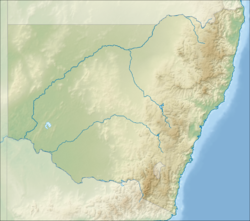| Robertson Nature Reserve | |
|---|---|
 Rainforest at Robertson Nature Reserve | |
| Location | New South Wales |
| Nearest city | Robertson |
| Coordinates | 34°35′36″S150°35′49″E / 34.59333°S 150.59694°E |
| Area | 0.053 km2 (0.020 sq mi) [1] |
| Established | January 1979 [1] |
| Governing body | NSW National Parks and Wildlife Service |
| Website | Official website |
The Robertson Nature Reserve is a protected rainforest nature reserve that is located in the Southern Highlands region of New South Wales, in eastern Australia. The 5.3-hectare (13-acre) reserve is situated near Robertson on the edge of the Illawarra Escarpment and is a remnant of the Yarrawa Brush, once 2,450 hectares (6,100 acres) in size. [2] [3]
